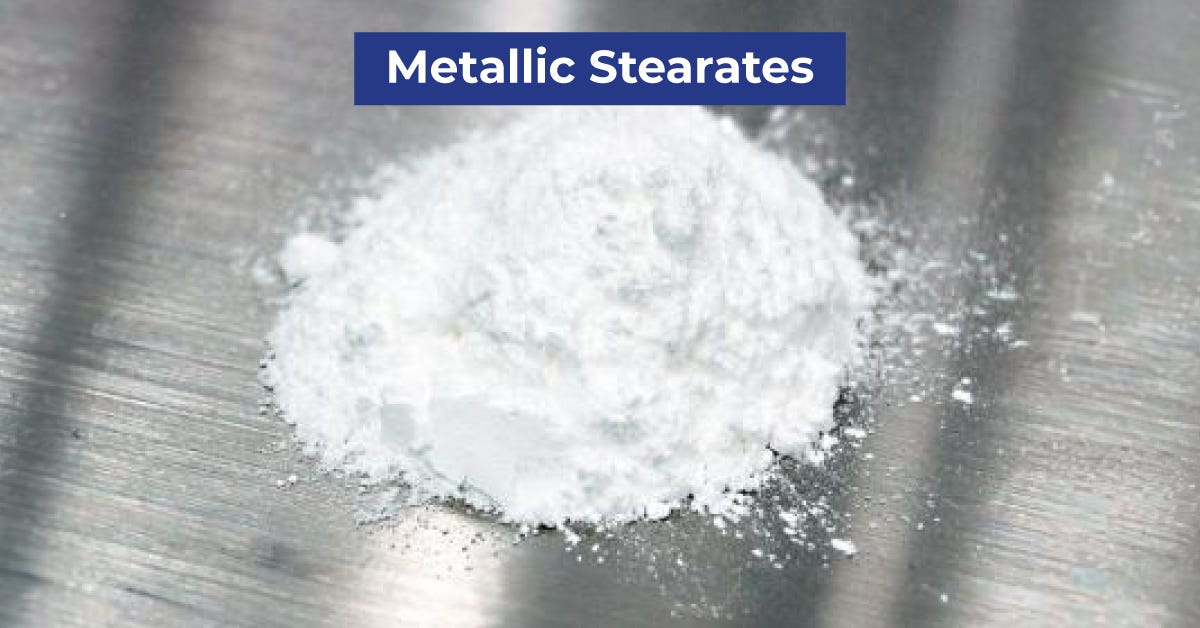
Metal stearates are compounds or metal soaps of long-chain fatty acids and alkali metals of different valency. When producing metallic stearates the carboxylic hydrogen of stearic acid is replaced with a metal cation derived from various metal oxides, metal sulfates, and metal chlorides. The most commonly used metallic stearates are aluminum stearate, calcium stearate, zinc stearate, and magnesium stearate. It extends across diverse sectors, including plastics, rubber, pharmaceuticals, and more.
Metal Stearates Manufacturing Process
The production of metal stearates involves several steps, including saponification of stearic acid with metal hydroxides or oxides, precipitation, and purification. The various methods, such as direct fusion, precipitation, and salt metathesis, are employed in their synthesis.
Benefits and Advantages of Metal Stearates
The various benefits of using metal stearates are better processing, lower friction, improved mechanical qualities, and longer product life. Their versatility makes them indispensable in optimizing manufacturing efficiency and product quality.
Challenges and Limitations of Metal Stearates
Despite their advantages, metal stearates may present challenges such as compatibility issues, over-lubrication, and potential toxicity concerns. However, advanced composition and application techniques mitigate these limitations, ensuring optimal performance and safety.
Environmental Impact Metal Stearates Manufacturers
The environmental impact of metal stearates have prompted efforts to develop sustainable practices and eco-friendly alternatives. Biodegradable formulations and recycling initiatives aim to minimize their ecological footprint while maintaining functionality.
Regulatory Framework of Metal Stearates
Regulations governing the use of Metal Stearates Manufacturers vary across regions, with stringent standards ensuring product safety and compliance with health and environmental regulations. Adherence to regulatory requirements is essential for manufacturers to maintain market access and consumer trust.
Future Trends and Innovations
The future of metal stearates lies in ongoing research and development efforts focused on enhancing their performance, sustainability, and cost-effectiveness. Innovations such as nanostructured additives and tailored formulations are expected to drive market growth and innovation.
Comparison with Alternatives
Compared to alternative additives, metal stearates offer distinct advantages in terms of cost-effectiveness, versatility, and compatibility with various materials. Their superior performance characteristics make them the preferred choice for many applications.
Market Analysis
The global market for metal stearates is experiencing steady growth, driven by increasing demand from end-use industries such as plastics, rubber, and cosmetics. Market players are focusing on product innovation and expansion strategies to capitalize on emerging opportunities.
Global Scenario
Metal stearate production and consumption are distributed globally, with major Metal Stearates Manufacturers hubs in regions like Asia-Pacific, Europe, and North America. Key market players include Baerlocher GmbH, FACI S.p.A., Peter Greven GmbH & Co. KG, and others.
Research and Development
Ongoing research efforts aim to explore novel applications, improve Metal Stearates Manufacturers processes, and address environmental concerns associated with metal stearates. Collaborative initiatives between industry stakeholders and research institutions drive innovation in this field.
Conclusion
The metal stearates play a vital role in various industrial processes. ALA Polystabs offering a wide range of benefits and applications. Despite challenges and regulatory considerations, their significance in optimizing manufacturing efficiency and product performance remains undeniable.

